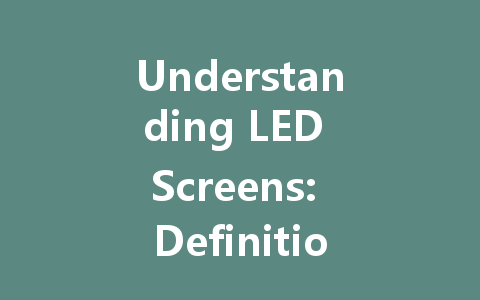
LED screens have revolutionized the way we view digital content, becoming the go-to choice for everything from televisions to large-scale advertising displays. This article will walk you through the essential aspects of LED screens, including their definition, design features, and other key characteristics that contribute to their widespread popularity.
What is an LED Screen?
LED stands for Light Emitting Diode, which is a semiconductor device that emits light when an electric current passes through it. An LED screen is essentially a flat panel display that uses this technology to create visual content. Unlike traditional LCD screens that rely on a backlight, LED screens use individual diodes to produce images directly, resulting in brighter colors and deeper contrasts.
One of the primary advantages of LED screens is their energy efficiency. Since they consume less power than older technologies, they are an ideal choice for both residential and commercial applications. Also, LED technology allows for thinner and lighter screens, making it easier to install in various settings.
The Design of LED Screens
When exploring LED screens, it is essential to understand their design. The most common types of LED screens include various configurations designed for specific applications. Here’s a brief overview of the main types:
These are the most familiar examples, where LED lights are used as a backlight to enhance traditional LCD screens. They maintain high color accuracy and enable thinner screens compared to traditional LCD screens that use CCFL (Cold Cathode Fluorescent Lamp) backlighting.
In OLED screens, individual pixels generate their own light, resulting in exceptional contrast and color depth. This technology allows parts of the screen to be completely turned off for true blacks, making it popular for high-end televisions and smartphones.
This design features individual LEDs that create images directly on the screen, often used in large outdoor displays, concert stages, or sports arenas. These screens are particularly bright and can withstand various weather conditions, making them ideal for outdoor advertising.
Key Features of LED Screens
Understanding the various features of LED screens can help you select the right type for your needs. Here are some of the most important aspects to consider:
Brightness and Color Quality
One of the standout features of LED screens is their brightness. They can produce vibrant colors and high levels of brightness, making them visible in well-lit environments, such as commercial spaces. Additionally, many LED screens offer a wide color gamut, which translates to a more colorful and lifelike display.
Resolution and Image Quality
LED screens are available in various resolutions, including HD (1080p), 4K, and even 8K formats. The higher the resolution, the sharper the images will appear. This characteristic is particularly important for applications where detail matters, such as in gaming or graphic design.
Durability and Lifespan
LED screens are known for their durability and long lifespan. They are designed to resist temperature fluctuations and impacts, making them suitable for both indoor and outdoor settings. The average lifespan of an LED screen can exceed 50,000 hours, ensuring you get maximum value from your investment.
Energy Efficiency
As earlier mentioned, LED screens are highly energy-efficient compared to traditional displays. This not only contributes to lower electricity bills but also lessens the environmental impact. The reduced energy consumption aligns with contemporary trends of sustainability.
Practical Applications of LED Screens
LED screens find applications across numerous industries, making them incredibly versatile. Here are some practical uses:
Home Entertainment
LED televisions dominate the home entertainment market, providing consumers with high-quality viewing experiences for movies, sports, and gaming. With advancements in technology, smart LED TVs even offer streaming capabilities and built-in applications.
Advertising and Signage
Businesses heavily rely on LED screens for advertising due to their bright displays and ability to capture attention in crowded environments. From digital billboards to indoor signage, LED technology allows companies to convey dynamic content and promotions instantly.
Event Displays
Large-scale events like concerts, festivals, or conferences frequently utilize LED screens to enhance the experience for attendees. Whether conveying information or showcasing performances, these screens create vibrant visuals that engage audiences.
Conclusion
In summary, LED screens are a remarkable innovation that has transformed visual technology for both personal and commercial use. Their design options, incredible brightness, and energy efficiency make them an attractive choice for a variety of applications. Understanding the different types of LED screens, their key features, and potential uses can help individuals and businesses make informed decisions about their display needs.
As technology continues to evolve, LED screens are likely to become even more sophisticated, paving the way for an enhanced visual experience in our daily lives.